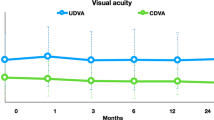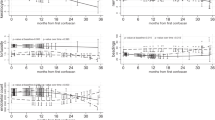Abstract
Purpose
To compare the changes in the measurement of corneal densitometry and total corneal higher-order aberrations (HOAs) between topical tacrolimus and transepithelial phototherapeutic keratectomy (Te-PTK) in the treatment of adenoviral corneal subepithelial infiltrates (SEIs).
Subject and methods
This is an interventional prospective randomized study, including 63 eyes of 35 patients with symptomatic adenoviral corneal SEIs for at least 6 months. All patients underwent previous topical steroid therapy associated with unsatisfactory response and/or complications. Patients were assigned into three groups: (1) Te-PTK group: Te-PTK with MMC 0.02% was performed by a Technolas; Teneo excimer laser; (2) tacrolimus group: tacrolimus 0.03% ointment was applied once daily for 2–6 months; the endpoint of treatment was based on the improvement in the corneal densitometry, BCVA, and OSDI; and (3) control group: no intervention was done. BCVA, corneal densitometry, and total corneal higher-order aberrations (HOAs) evaluation using Pentacam HR were done at the baseline, 1 week, and then 1, 3, 6, and 12 months of the study.
Results
The study population was similar between all groups. The mean follow-up was 12.75 ± 0.9 months. Bilateral corneal SEI was recorded at 80%. At 12-month follow-ups, the mean BCVA improved in both the Te-PTK and tacrolimus groups without significant changes in the control group. The mean corneal densitometry of the anterior, central, and total cornea decreased significantly in the Te-PTK and tacrolimus groups. HO-RMS and total RMS decreased significantly in the Te-PTK and tacrolimus groups. BCVA, corneal densitometry (anterior, central, and total cornea), and corneal aberrations (total coma, total trefoil, HO-RMS, and total RMS) values were significantly better for the Te-PTK and tacrolimus groups than the control group. There were no statistically significant differences between Te-PTK and tacrolimus groups in terms of BCVA, corneal densitometry, corneal HOA, and the persistence of corneal SEIs. The persistence of corneal SEIs was significantly lower in Te-PTK and tacrolimus groups than the control group.
Conclusion
Te-PTK and topical tacrolimus are effective methods for the treatment of adenoviral corneal SEIs improving visual acuity, corneal densitometry, and corneal HOA. The densitometry program of the Pentacam may give an objective guide for the treatment of adenoviral corneal SEIs.
Trial registration: ClinicalTrials.gov ID is NCT04267991.






Similar content being viewed by others
Data availability
All data used to support the findings of this study are available from the corresponding author upon request without an end date.
Abbreviations
- EKC:
-
Epidemic keratoconjunctivitis
- SEIs:
-
Subepithelial infiltrates
- MMC:
-
Mitomycin C (MMC)
- Te-PTK:
-
Transepithelial phototherapeutic keratectomy
- GSU:
-
Grayscale unit
- BCVA:
-
Best corrected visual acuity
- Log MAR:
-
Logarithm of the minimum angle of resolution
- OSDI:
-
Ocular surface disease index
- HOA-RMS:
-
Higher-order aberration root mean square
- SA:
-
Spherical aberration
- COT:
-
Corneal opacity thickness
- D:
-
Diopter
- BSS:
-
Balanced salt solution
References
Jhanji V, Chan TC, Li EY et al (2015) Adenoviral keratoconjunctivitis. Surv Ophthalmol 60(5):435–443
Kaufman HE (2011) Adenovirus advances: new diagnostic and therapeutic options. Curr Opin Ophthalmol 22(4):290–293
Altan-Yaycioglu R, Sahinoglu-Keskek N, Canan H et al (2019) Effect of diluted povidone iodine in adenoviral keratoconjunctivitis on the rate of subepithelial corneal infiltrates. Int J Ophthalmol 12(9):1420
Okumus S, Coskun E, Tatar MG et al (2012) Cyclosporine a 0.05% eye drops for the treatment of subepithelial infiltrates after epidemic keratoconjunctivitis. BMC Ophthalmol. 12(1):42
Otri AM, Fares U, Al-Aqaba MA et al (2012) Corneal densitometry as an indicator of corneal health. Ophthalmology 119(3):501–508
Muftuoglu IK, Akova YA, Gungor SG (2016) Effect of 0.05% topical cyclosporine for the treatment of symptomatic subepithelial infiltrates due to adenoviral keratoconjunctivitis. Int J Ophthalmol 9(4):634
Kuo IC (2019) Adenoviral keratoconjunctivitis: diagnosis, management, and prevention. Current Ophthalmol Rep 7(2):118–127
Jeng BH, Holsclaw DS (2011) Cyclosporine A 1% eye drop for the treatment of subepithelial infiltrates after adenoviral keratoconjunctivitis. Cornea 30(9):958–961
Levinger E, Slomovic A, Sansanayudh W et al (2010) Topical treatment with 1% cyclosporine for subepithelial infiltrates secondary to adenoviral keratoconjunctivitis. Cornea 29(6):638–640
Gallego-Pinazo R, Dolz-Marco R, Martínez-Castillo S et al (2013) Update on the principles and novel local and systemic therapies for the treatment of non-infectious uveitis. Inflamm Allergy Drug Targets 12(1):38–45
Shoughy SS (2017) Topical tacrolimus in anterior segment inflammatory disorders. Eye Vis 4(1):7
Fukushima A, Ohashi Y, Ebihara N et al (2014) Therapeutic effects of 0.1% tacrolimus eye drops for refractory allergic ocular diseases with proliferative lesion or corneal involvement. Br J Ophthalmol 98(8):1023–7
Magalhaes OA, Marinho DR, Kwitko S (2013) Topical 0.03% tacrolimus preventing rejection in high-risk corneal transplantation: a cohort study. Br J Ophthalmol 97(11):1395–8
Reddy JC, Rapuano CJ, Felipe AF et al (2014) Quality of vision after excimer laser phototherapeutic keratectomy with intra operative mitomycin-C for Salzmann nodular degeneration. Eye Contact Lens 40(4):213–219
Lee CS, Lee AY, Akileswaran L et al (2018) Determinants of outcomes of adenoviral keratoconjunctivitis. Ophthalmology 125(9):1344–1353
Ye MJ, Liu CY, Liao RF et al (2016) SMILE and wave front-guided LASIK out-compete other refractive surgeries in ameliorating the induction of high-order aberrations in anterior corneal surface. J Ophthalmol 2016:8702162
Hu Y, Fang L, Guo X et al (2018) Corneal configurations and high-order aberrations in primary congenital glaucoma. J Glaucoma 27(12):1112–1118
Elflein HM, Hofherr T, Berisha-Ramadani F et al (2013) measuring corneal clouding in patients suffering from mucopolysaccharidosis with the Pentacam densitometry programme. Br J Ophthalmol 97(7):829–833
Takacs AI, Mihaltz K, Nagy ZZ (2011) Corneal density with the Pentacam after photorefractive keratectomy. J Refract Surg 27(4):269–277
Urbaniak D, Seredyka-Burduk M, Błoch W et al (2018) Scheimpflug camera measurement of optical density of the corneal epithelium, stroma, and endothelium in patients with pseudoexfoliation syndrome. Med Sci Monitor Int Med J Experim Clin Res 24:5826
Tekin K, Sekeroglu MA, Kiziltoprak H et al (2017) Corneal densitometry in healthy corneas and its correlation with endothelial morphometry. Cornea 36(11):1336–1342
Oliveira CM, Ferreira A, Franco S (2012) Wave front analysis and Zernike polynomial decomposition for evaluation of corneal optical quality. J Cataract Refract Surg 38(2):343–356
Tomlinson A, Bron AJ, Korb DR et al (2011) The international workshop on meibomian gland dysfunction: report of the diagnosis subcommittee. Invest Ophthalmol Vis Sci 52(4):2006–2049
Asrar A, Ikram B, Khan H et al (2016) Normal values of corneal optical densitometry using pentacam scheimpflug camera. Adv Ophthalmol Vis Syst 5(1):00142
Dhubhghaill SN, Rozema JJ, Jongenelen S et al (2014) Normative values for corneal densitometry analysis by Scheimpflug optical assessment. Invest Ophthalmol Vis Sci 55(1):162–168
Otri AM, Fares U, Al-Aqaba MA et al (2012) Corneal densitometry as an indicator of corneal health. Ophthalmology 119:501–508
Nagpal R, Maharana PK, Roop P et al (2020) Phototherapeutic keratectomy. Surv Ophthalmol 65(1):79–108
Reinstein DZ, Archer TJ, Dickeson ZI et al (2014) Transepithelial phototherapeutic keratectomy protocol for treating irregular astigmatism based on population epithelial thickness measurements by artemis very high-frequency digital ultrasound. J Refract Surg 30(6):380–387
Labib BA, Minhas BK, Chigbu DI (2020) Management of adenoviral keratoconjunctivitis: challenges and solutions. Clin Ophthalmol 14:837
Prado SB, Ayora AC, Fernández CL et al (2017) Topical tacrolimus for corneal subepithelial infiltrates secondary to adenoviral keratoconjunctivitis. Cornea 36(9):1102–1105
Kovalyuk N, Kaiserman I, Mimouni M et al (2017) Treatment of adenoviral keratoconjunctivitis with a combination of povidone-iodine 1.0% and dexamethasone 0.1% drops: a clinical prospective controlled randomized study. Acta Ophthalmol 95(8):e686–92
Pihos AM (2013) Epidemic keratoconjunctivitis: a review of current concepts in management. J Optometry 6(2):69–74
Tekin K, Kiziltoprak H, Koc M et al (2019) The effect of corneal infiltrates on densitometry and higher-order aberrations. Clin Exp Optometry 102(2):140–146
Aydin Kurna S, Altun A, Oflaz A et al (2015) Evaluation of the impact of persistent subepithelial corneal infiltrates on the visual performance and corneal optical quality after epidemic keratoconjunctivitis. Acta Ophthalmol 93:377–382
Ghanem RC, da Costa Vargas JF, Ghanem VC (2014) Tacrolimus for the treatment of subepithelial infiltrates resistant to topical steroids after adenoviral keratoconjunctivitis. Cornea 33(11):1210–1213
Levinger E, Trivizki O, Shachar Y et al (2014) Topical 0.03% tacrolimus for subepithelial infiltrates secondary to adenoviral keratoconjunctivitis. Graefe's Arch Clin Exp Ophthalmol 252(5):811–6
Khurana RN, Li Y, Tang M et al (2007) High-speed optical coherence tomography of corneal opacities. Ophthalmology 114(7):1278–1285
Yildiz BK, Urvasizoglu S, Yildirim Y et al (2017) Changes in higher-order aberrations after phototherapeutic keratectomy for subepithelial corneal infiltrates after epidemic keratoconjunctivitis. Cornea 36(10):1233–1236
Oliveira RF, Ferreira GA, Ghanem VC et al (2020) Transepithelial surface ablation with mitomycin c for the treatment of chronic central corneal scars following adenoviral keratoconjunctivitis. J Refract Surg 36(1):55–61
Yamazaki ES, Ferraz CA, Hazarbassanov RM et al (2011) Phototherapeutic keratectomy for the treatment of corneal opacities after epidemic keratoconjunctivitis. Am J Ophthalmol 151(1):35–43
Mallias IA, Mylova P, Mouzaka A et al (2016) Phototherapeutic keratectomy for the treatment of dense subepithelial infiltrates after epidemic keratoconjunctivitis. Ophthalmol J 1(4):147–150
Medeiros CS, Marino GK, Santhiago MR et al (2018) The corneal basement membranes and stromal fibrosis. Invest Ophthalmol VisSci 59(10):4044–4053
Ghanem RC, Ghanem VC, Ghanem EA et al (2012) Corneal wavefront-guided photorefractive keratectomy with mitomycin-C for hyperopia after radial keratotomy: two-year follow-up. J Cataract Refract Surg 38(4):595–606. https://doi.org/10.1016/j.jcrs.2011.11.032
Alevi D, Barsam A, Kruh J et al (2012) Photorefractive keratectomy with mitomycin-C for the combined treatment of myopia and subepithelial infiltrates after epidemic keratoconjunctivitis. J Cataract Refract Surg 38(6):1028–1033
Reddy JC, Rapuano CJ, Felipe AF et al (2014) Quality of vision after excimer laser phototherapeutic keratectomy with intraoperative mitomycin-C for Salzmann nodular degeneration. Eye Contact Lens 40:213–219
Sakata N, Tokunaga T, Miyata K et al (2007) Changes in contrast sensitivity function and ocular higher order aberration by conventional myopic photorefractive keratectomy. Jpn J Ophthalmol 51(5):347–352
Acknowledgements
No financial support was received for this submission. No substantial contribution was provided for this submission.
Author information
Authors and Affiliations
Corresponding author
Ethics declarations
Conflict of interest
The author declares no conflict of interest.
Additional information
Publisher's Note
Springer Nature remains neutral with regard to jurisdictional claims in published maps and institutional affiliations.
Rights and permissions
About this article
Cite this article
Elhamaky, T.R. Pentacam corneal densitometry-guided treatment of adenoviral corneal subepithelial infiltrates: a comparative study between transepithelial phototherapeutic keratectomy and topical tacrolimus. Int Ophthalmol 41, 67–77 (2021). https://doi.org/10.1007/s10792-020-01553-8
Received:
Accepted:
Published:
Issue Date:
DOI: https://doi.org/10.1007/s10792-020-01553-8




